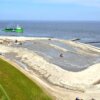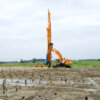Vibratory surface compaction is a method used on the surface of a reclamation area to increase the density, shear strength, and stiffness of the fill.
This compaction method is undertaken at the surface of the site using vibratory rollers, plates and/or tampers. It is often used in road and airfield construction to compact the sub-base and base courses consisting of granular material such as rock fill and sand or in foundation construction to compact the soil underneath shallow foundations.
While moving forward, the vibratory rollers combine static pressure and dynamic loading using vibrations with low amplitude and high frequency that re-arranges the grains into a denser state. Non-vibrating pad foot rollers and tyre rollers are more effective in cohesive materials as a result of their kneading action. This compaction method involves various types of equipment:
- single-drum vibratory rollers,
- towed single-drum vibratory rollers,
- vibratory tandem rollers,
- hand-held tampers, and
- vibratory plate compactors.
Most of the vibratory rollers have a smooth drum and are suitable for granular material only. Vibratory rollers have weights that typically range between 4 and 25 tonnes and generally move at speeds not exceeding 6 kilometres per hour.
A special development is the polygonal drum roller consisting of three octagonal drum elements placed next to each other. According to reports, the combination of this special drum shape (weight 14 to 26 tonnes) with the high dynamic forces enables an optimum introduction of the compression and shear waves into the soil.
The influence depth of vibratory rollers is limited and varies between 0.30 m and 0.80 metres, depending on the type of soil to be compacted and the equipment used. In practice, vibratory rollers are only used for fill layers of limited thickness. However, discharge capacities of modern dredgers results in layer thicknesses not less than 2 to 3 metres. This implies that the use of vibratory rollers is limited to the uppermost layer only.
Deep vibratory compaction (vibro compaction)
During deep vibratory compaction grains are rearranged into a more dense state by the vibrations transmitted from vibrating probes that are inserted into the ground. Deep vibratory compaction has been developed to compact granular soils to depths of more than 30 metres. The deep vibratory method is limited to granular soils, usually with a maximum fines content of 10-15 percent.
Probes are inserted into the ground at so-called compaction points, which are most commonly arranged on a triangular grid pattern over the area to be compacted. Operational parameters such as the grid spacing of the compaction points, the duration of the vibration time, and the rate of withdrawal of the probe are in most cases determined during compaction trials undertaken at the project site itself.
The primary difference between the various techniques of deep vibratory compaction is the design of the probe. Based on this design deep vibratory compaction techniques can be divided into:
- vibratory probes without water or air jets vibrating in vertical direction;
- vibroflotation with water and/or air jets vibrating in horizontal direction.
In situ tests, such as the Cone Penetration Test may be carried out to verify the required quality of the soil improvement. The actual positions of the Cone Penetration Tests for verification of the achieved improvement should preferably be specified in the Contract documents in order to avoid discussions during the execution of the works. It is also important to accurately localise the actual coordinates of the pre- and post-compaction test locations.
Vibratory probes without jets
The principle of vibratory probes is based on compaction of granular material as a result of vertically polarised waves transmitted into the soil by a long vibrating probe. The vibrations are generated by a heavy vibrator clamped at the upper end of the probe exciting the probe over its full length in a vertical direction. The probe is inserted into the soil and vibrated down to the maximum depth. The spacing between insertion points of the probe ranges typically between 1.5 and 4.0 metres and is generally smaller than for vibroflotation. The probe is usually suspended from a crane or guided mast.
Modern vibrators are hydraulically driven and often the vibration frequency can be varied during operation. Vibratory probes are developed to compact granular material to depths ranging from 10 to 15 metres.
Different types of compaction probes have been developed in Japan, North America and Europe.
Vibroflotation with water and/or air jets
Vibroflotation relies on the fact that particles of non-cohesive soil can be re-arranged into a denser state under the influence of vibrations from specially designed vibratory probes. The action of the vibratory probe, usually accompanied by water and/or air jetting to temporarily reduce the inter-granular forces between the soil particles, allows the grains to move into a more compact configuration.
Vibroflotation is used for in-situ compaction of thick layers of loose granular soil deposits to depths that may exceed 30 metres. In loose to medium dense saturated sands, the strong ground vibrations in the immediate vicinity of the probe will result in an increase of pore-water pressure in the soil column surrounding the vibratory probe. Compaction with vibratory probes is limited to granular materials only. An increase of the fines content will reduce the permeability and, hence, the efficiency of the compaction method. The efficiency of vibroflotation is generally higher than the efficiency of vibratory probes without water or air jets.
Compaction trials on site
For most compaction techniques, a trial must be executed at the actual project site to establish the optimum grid spacing, frequency and amplitude, and the vertical vibration interval to achieve the required degree of compaction.
The European Standard “EN 14731:2005, Execution of Special Geotechnical Works, Ground treatment by deep vibration” provides information on the planning, execution, testing and monitoring of vibroflotation.
















